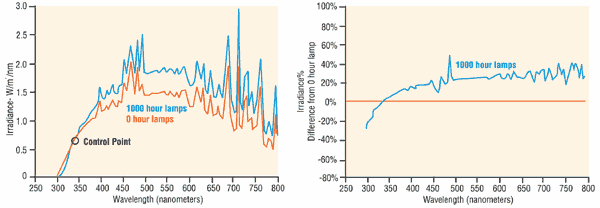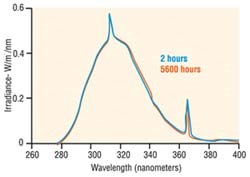Putting Coatings to the Test
A comparison of two effective approaches to accelerated weathering and light stability testing...
Weathering and light exposure are important causes of damage to coatings, plastics and other organic materials. The damage can include gloss loss, fading, yellowing, crackling, peeling, embrittlement, loss of tensile strength and delamination. Even indoor lighting and sunlight through window glass can degrade some materials like pigments and dyes.
This article explores two testing methods, including emission spectra and method of moisture simulation. The inherent strengths and weaknesses of each testing method are presented. Guidelines will be recommended for a particular material or application.
While it is clear that weatherability and light stability are important for many products, the best way to test is sometimes controversial. Various methods have been used. Most researchers now use natural exposure testing, the xenon arc or the accelerated weathering tester.
Natural exposure testing has many advantages: it is realistic, inexpensive and easy to perform. However, you may not have several years to wait on a product.
Xenon arc and weathering are the most commonly used accelerated testers. The two testers are based on completely different approaches. The xenon test chamber reproduces the entire spectrum of sunlight, including UV, visible light and infrared in an attempt to reproduce sunlight.
The accelerated weathering tester does not attempt to reproduce sunlight, just its damaging effects. It is based on the concept that, for durable material exposed outdoors, short wave UV causes the most weathering damage.
Which is the better way to test? There is no simple answer. Depending on your application, either approach can be effective. The choice should depend on the product or material you are testing, the end-use application, the degradation mode you are concerned with and budgetary restrictions.
Sunlight Simulation
Accelerated weathering testers reproduce the damaging effects of sunlight on durable materials using fluorescent UV lamps. These lamps are electrically similar to the common cool white lamps used in general lighting, but produce mainly UV rather than visible light or infrared.
There are different types of lamps with different spectra for various exposure applications. UVA-340 lamps provide the best available simulation of sunlight in the critical short-wave UV region. The spectral power distribution (SPD) of the UVA-340 matches sunlight closely from the solar cutoff to about 360 nm. UV-B lamps are also commonly used in the accelerated weathering tester. They typically cause faster degradation than UV-A lamps, but their short wavelength output below the solar cutoff can cause unrealistic results for many materials.
Control of Irradiance
Irradiance (light intensity) control is necessary to achieve accurate and reproducible test results. Many accelerated weathering models are equipped with irradiance control systems. This precision light control system allows the user to choose the level of irradiance. With the control system’s feedback loop, the irradiance is continuously and automatically monitored and precisely maintained. The controller automatically compensates for lamp aging or any other variability by adjusting power to the lamps.
Irradiance control is simplified by the inherent spectral stability of the fluorescent UV lamps. All light sources decline in output as they age. However, unlike most other types, fluorescent lamps experience no shift in spectral power distribution over time. This enhances the reproducibility of test results and is a major advantage.
Figure 2 shows a comparison between a lamp aged for two hours and a lamp aged for 5,600 hours in an accelerated weathering system with irradiance control. The difference in output between the new and aged lamps is nearly indistinguishable. The irradiance controller has maintained the light intensity. In addition, the spectral power distribution remains virtually unchanged.
Moisture Simulation
A major benefit of using accelerated weathering is that it allows the most realistic simulation of outdoor moisture attack. Outdoors, materials are frequently wet up to 12 hours a day. Because most of this moisture is the result of dew, the system uses a special condensation mechanism to reproduce outdoor moisture.
During the condensation cycle, a water reservoir in the bottom of the test chamber is heated to produce vapor. The hot vapor maintains the chamber environment at 100% relative humidity, at an elevated temperature. The system is designed so that the test specimen actually form the sidewall of the chamber. Thus, the reverse side of the specimens is exposed to ambient room air. Room air-cooling causes the test surface to drop a few degrees below the vapor temperature. This temperature difference causes liquid water to continually condense on the test surface throughout the condensation cycle.
The resulting condensate is stable, pure distilled water. This water increases the reproducibility of test results, precludes water-spotting problems and simplifies installation and operation.
Because materials experience long wet times outdoors, the typical system condensation cycle is at least four hours. The condensation is conducted at an elevated temperature (50C), which greatly accelerates the moisture attack. The system’s long, hot condensation cycle reproduces the outdoor moisture phenomenon better than other methods, such as water spray, immersion or high humidity.
In addition to the standard condensation mechanism, the accelerated weathering tester can also be fitted with a water spray system to simulate other damaging end-use conditions, such as thermal shock or mechanical erosion. The user can program the system to produce cycles of wetness alternating with UV, a situation that is identical to natural weathering.
Xenon Test Chamber
Xenon arc testers are considered the best simulation of full-spectrum sunlight because they produce UV, visible light and infrared. Understanding xenon arc spectra is complicated by two factors: optical filter systems and lamp stability.
Xenon arcs must be filtered to reduce unwanted radiation. Several types of glass filters are available to achieve various spectra. The filters used depend on the material tested and its end-use application. Different filter types allow for varying amounts of short wave UV, which can significantly affect the speed and type of degradation. There are three commonly used filters: daylight, window glass and extended UV.
Xenon arc testers are typically equipped with an irradiance control system. Irradiance control is important in xenon testers because the lamps are inherently less spectrally stable than fluorescent UV lamps.Figure 3 illustrates the difference in spectrum between a new lamp and a lamp that has been operated for 1,000 hr. Over time, the spectrum changes significantly in the longer wavelength. However, when this same data is graphed as a percentage of change over time, it also becomes apparent that there is a similar shift in the short wave UV portion of the spectrum.
| Accelerated Weathering vs. Xenon Arc | |
| Accelerated Weathering | Xenon Arc |
| Better in the short wave UV | Better match with sunlight in the long wave UV and visible spectrum |
| Better at simulating the effects of outdoor moisture | Better for controlling humidity |
| Better for testing polymer degradation | Better for testing color change |
| Meets coating specifications: ASTM D3994; ASTM D4587; NACE TM-01-84; Nissan M0007; FED-STD-141B. | Meets coating specifications: ASTM D3451;ASTM D3794; ASTM D6695; ISO 11341 |
This change in spectrum is due to aging is an inherent characteristic of xenon arc lamps; however, there are ways to compensate for this. Lamps can be replaced on a more frequent basis to minimize the effects of lamp aging. Also, sensors can control irradiance at either 340 or 420 nm. Despite the spectral shift from lamp aging, the xenon arc is a reliable and realistic light source for weatherability and light stability testing.
Moisture Simulation
Most xenon arc testers simulate the effects of moisture through water spray and/or humidity control system. The limitation of water spray is that when relatively cold water is sprayed onto a relatively hot test specimen, the specimen cools down. This may slow the degradation; however, water spray is useful for simulating thermal shock and erosion. In a xenon arc, highly purified water is necessary to prevent water spotting.
Because humidity can affect the degradation type and rate of certain indoor products, such as many textiles and inks, controlling relative humidity is recommended in many test specifications.
Practical Considerations
No matter how informative and realistic a piece of testing equipment is, it will not be practical if it is too expensive to purchase or operate.
When evaluating the purchase price of a unit, specimen capacity should be considered. You should also consider the units’ flexibility in holding parts.
Related Content
Coatings Plant Evolves with Market Trends
Expanding its focus from exclusively serving the RV industry, one of this company’s stand-alone coatings plant has successfully extended its services to additional markets.
Read MoreConcrete Reinforced Bars Built to Last
Not all corrosion-resistant materials for infrastructure are created equally. Epoxy-coated steel rebar has advantages that other materials used to prevent corrosion do not.
Read MoreConveyors and Paint Systems
Choosing the right conveyor system, coating technology, and ancillary equipment.
Read MoreCobot Enters Paint Industry With Safety at the Forefront
This collaborative robot is the first explosion-proof solution for the powder coating and paint arena that meets the U.S.’ stringent safety requirements. Its lead-through teach programming and tablet control are especially appealing to small shops with little proficiency in robotics.
Read MoreRead Next
Episode 45: An Interview with Chandler Mancuso, MacDermid Envio Solutions
Chandler Mancuso, technical director with MacDermid Envio discusses updating your wastewater treatment system and implementing materials recycling solutions to increase efficiencies, control costs and reduce environmental impact.
Read MoreDelivering Increased Benefits to Greenhouse Films
Baystar's Borstar technology is helping customers deliver better, more reliable production methods to greenhouse agriculture.
Read MoreEducation Bringing Cleaning to Machining
Debuting new speakers and cleaning technology content during this half-day workshop co-located with IMTS 2024.
Read More















.jpg;maxWidth=300;quality=90)








